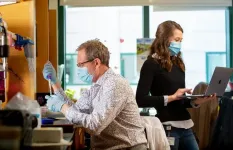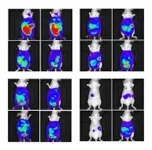Body's natural pain killers can be enhanced
A study in cells and mice finds compound works with fewer side effects than opioids
2021-04-23
(Press-News.org) Fentanyl, oxycodone, morphine--these substances are familiar to many as a source of both pain relief and the cause of a painful epidemic of addiction and death.
Scientists have attempted for years to balance the potent pain-relieving properties of opioids with their numerous negative side effects--with mostly mixed results.
Work by John Traynor, Ph.D., and Andrew Alt, Ph.D., and their team at the University of Michigan Edward F. Domino Research Center, funded by the National Institute on Drug Abuse, seeks to side-step these problems by harnessing the body's own ability to block pain.
All opioid drugs--from poppy-derived opium to heroin--work on receptors that are naturally present in the brain and elsewhere in the body. One such receptor, the mu-opioid receptor, binds to natural pain-killers in the body called endogenous endorphins and enkephalins. Drugs acting on the mu-opioid receptor can cause addiction as well as unwanted side effects like drowsiness, problems with breathing, constipation and nausea.
"Normally, when you are in pain, you are releasing endogenous opioids, but they're just not strong enough or long lasting enough," says Traynor. The team had long hypothesized that substances called positive allosteric modulators could be used to enhance the body's own endorphins and enkephalins. In a new paper published in PNAS, they demonstrate that a positive allosteric modulator known as BMS-986122 can boost enkephalins' ability to activate the mu-opioid receptor.
What's more, unlike opioid drugs, positive allosteric modulators only work in the presence of endorphins or enkephalins, meaning they would only kick in when needed for pain relief. They do not bind to the receptor in the way that opioids do instead binding in a different location that enhances its ability to respond to the body's pain-relieving compounds.
"When you need enkephalins, you release them in a pulsatile fashion in specific regions of the body, then they are metabolized quickly," explains Traynor. "In contrast, a drug like morphine floods the body and brain and sticks around for several hours."
The team demonstrated the modulator's ability to stimulate the mu-opioid receptor by isolating the purified receptor and measuring how it responds to enkephalins. "If you add the positive allosteric modulator, you need a lot less enkephalin to get the response."
Additional electrophysiology and mouse experiments confirmed that the opioid receptor was more strongly activated by the body's pain-relieving molecules leading to pain relief. In contrast the modulator showed much reduced side effects of depression of breathing, constipation and addiction liability.
Their next goal is to measure their ability to enhance activation of endogenous opioids under conditions of stress or chronic pain, explains Traynor, to ensure that they are effective but don't lead to more dangerous responses like depression of breathing.
"While these molecules won't solve the opioid crisis," says Traynor, "they could slow it and prevent it from happening again because patients in pain could take this type of a drug instead of a traditional opioid drug."
INFORMATION:
Paper Cited: "Positive allosteric modulation of the mu-opioid receptor produces analgesia with reduced side effects," Proceedings of the National Academy of Sciences. DOI: 10.1073/pnas.2000017118
ELSE PRESS RELEASES FROM THIS DATE:
2021-04-23
LEBANON, NH - Researchers at Dartmouth's and Dartmouth-Hitchcock's Norris Cotton Cancer Center (NCCC) hope to make estrogen therapy a more accessible treatment option for breast cancer patients who could benefit from it. Anti-estrogen treatments, which block growth signals from estrogen receptors (ER) in tumors, are effective treatments for ER+ breast cancer. But it is common for breast tumors to become resistant to anti-estrogen treatments over time. The research team, led by molecular biologist Todd Miller, PhD, and Nicole Traphagen, a PhD candidate in the Miller Laboratory, found that in mice, cycling between estrogen treatment and anti-estrogen treatment at a specific point in time can dramatically increase ...
2021-04-23
FRANKFURT. Originally, oxygen radicals - reactive oxygen species, or ROS for short - were considered to be exclusively harmful in the body. They are produced, for example, by smoking or UV radiation. Because of their high reactivity, they can damage many important molecules in cells, including the hereditary molecule DNA. As a result, there is a risk of inflammatory reactions and the degeneration of affected cells into cancer cells.
Because of their damaging effect, however, ROS are also deliberately produced by the body, for example by immune or lung epithelial cells, which destroy invading bacteria and viruses with ROS. This requires relatively high ROS concentrations. In low concentrations, on the ...
2021-04-23
Copper remains one of the single most ubiquitous metals in everyday life. As a conductor of heat and electricity, it is utilized in wires, roofing and plumbing, as well as a catalyst for petrochemical plants, solar and electrical conductors and for a wide range of energy related applications. Subsequently, any method to harvest more of the valuable commodity proves a useful endeavor.
Debora Rodrigues, Ezekiel Cullen Professor of Engineering at the University of Houston Cullen College of Engineering, in collaboration with Francisco C. Robles Hernandez, ...
2021-04-23
Anyone with children knows that while controlling one child can be hard, controlling many at once can be nearly impossible. Getting swarms of robots to work collectively can be equally challenging, unless researchers carefully choreograph their interactions -- like planes in formation -- using increasingly sophisticated components and algorithms. But what can be reliably accomplished when the robots on hand are simple, inconsistent, and lack sophisticated programming for coordinated behavior?
A team of researchers led by Dana Randall, ADVANCE Professor of Computing and Daniel Goldman, Dunn Family Professor of Physics, both at Georgia Institute of Technology, sought to show that ...
2021-04-23
Smoking is the leading cause of preventable death in America and causes about 30% of all cancer deaths. That's why researchers with the UC Davis Comprehensive Cancer Center wanted to study the impact of a California law passed in 2016 that raised the tobacco sales age from 18 to 21. Their new study published in Preventive Medicine examines smoking behavior after the state implemented one of the first tobacco 21 (T21) policies.
The study, conducted by UC Davis researchers Melanie Dove, Susan Stewart and Elisa Tong, looked at smoking patterns before and after the law passed and compared California and other states without a T21 policy. The data was from the 2012-2019 Behavioral Risk Factor Surveillance System.
"Most adult tobacco users start smoking ...
2021-04-23
Batteries are a part of everyday modern life, powering everything from laptops, phones and robot vacuums to hearing aids, pacemakers and even electric cars. But these batteries potentially pose safety and environmental risks.
In a study recently published in Cell Reports Physical Science, researchers at Texas A&M University investigated the components of a different kind of battery -- a metal-free, water-based battery -- which would reduce the flammable nature of standard batteries and decrease the number of metal elements used in their production.
Most batteries are ...
2021-04-23
Researchers led by Katsunori Tanaka and Kenward Vong at the RIKEN Cluster for Pioneering Research (CPR) in Japan have demonstrated that tumor growth can be reduced by therapy that tags cancer cells with different therapeutic molecules. In one case, the group was able to prevent tumors from forming in mice by targeting cancer cells with a compound that makes it difficult for the cells to clump together and form tumors. For tumors that already existed, they targeted cancer cells with toxic compounds that destroyed them. This study was published on April 23 in Science Advances.
One of the major problems with current cancer treatments is that their effects are not limited to cancerous cells in ...
2021-04-23
An international team of researchers led by the University of Bergen has uncovered how organisms from crops to corals may avoid deadly DNA damage during evolution.
Our cells, and those of animals, plants and fungi, contain compartments that produce chemical fuel. These compartments contain their own DNA, which stores instructions for important cellular machinery. But this so-called oDNA (organelle DNA) can become mutated, corrupting the instructions and preventing cells making enough energy.
In humans and some other animals, a process called the "bottleneck" allows some offspring to inherit less mutated oDNA. This process needs mothers' egg cells to develop early, like in humans, where a human girl is born with all ...
2021-04-23
DURHAM, N.C. - Fruits and veggies are good for you and if you are a lemur, they may even help mitigate the effects of habitat loss.
A new study sequencing the genome of four species of sifakas, a genus of lemurs found only in Madagascar's forests, reveals that these animals' taste for leaves runs all the way to their genes, which are also more diverse than expected for an endangered species.
Sifakas are folivores, meaning that the bulk of their diet is composed of leaves. Leaves can be difficult to digest and full of toxic compounds meant to prevent them from being eaten. Unlike our carefully selected spinach, tree leaves also don't taste great, and are not very nutritious.
Because of that, leaf-eaters ...
2021-04-23
Strenuous efforts to prevent and treat malaria in recent decades have brought great benefits, particularly against disease caused by Plasmodium falciparum in countries in Africa and the Americas. But malaria caused by its "stealthier and more resilient cousin", P. vivax, now needs to be confronted with high priority, say Lorenz von Seidlein and Nicholas White of the Mahidol Oxford Tropical Medicine Research Unit in Bangkok, Thailand in a Perspective. The piece introduces a Collection on the prevention and treatment of P. vivax malaria in the open access journal PLOS Medicine, published ahead of World Malaria Day on April 25th.
In a Review article in the Collection, Sarah Auburn of the Menzies School of Health Research and Charles Darwin University, Darwin, Australia ...
LAST 30 PRESS RELEASES:
[Press-News.org] Body's natural pain killers can be enhanced
A study in cells and mice finds compound works with fewer side effects than opioids





